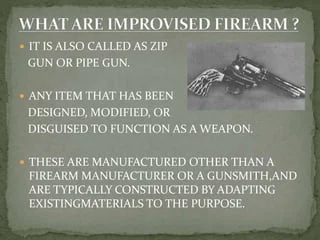An exploration of the various types of improvised firearms Found in India along with impact and legal and regulatory framework
Uncategorized
Improvised Firearm
An improvised firearm, often referred to as a “homemade gun” or “zip gun,” is a firearm manufactured using parts that are not originally intended for use in firearms. These makeshift weapons are often created illegally and can pose serious safety risks due to their lack of proper design, materials, and testing. This essay will discuss the nature of improvised firearms, their implications, and the challenges they pose to society and law enforcement. One of the defining characteristics of improvised firearms is their simplicity. These weapons can be constructed using basic tools and materials that are often readily available. For example, a pipe shotgun can be made using a metal pipe, a nail or screw as a firing pin, and a simple mechanism to strike the firing pin. While the construction of improvised firearms may vary in complexity, they all share the common feature of being made from non-traditional firearm components.
The proliferation of improvised firearms poses several significant implications. First and foremost, these weapons can be extremely dangerous. Due to their makeshift nature, improvised firearms are often not well-made or designed, which can lead to safety issues such as accidental discharge, misfires, and malfunctions. This can result in serious injuries or even death to the user or bystanders. Additionally, improvised firearms are often used in criminal activities. Their easy availability and low cost make them attractive to individuals involved in criminal enterprises. These weapons are commonly used in robberies, assaults, and other violent crimes. The use of improvised firearms can also present challenges for law enforcement. These weapons are often difficult to trace and may not be easily identifiable as firearms, making it harder for law enforcement to investigate crimes involving them.
To address the issue of improvised firearms, several measures can be taken. Strengthening gun control laws and increasing enforcement efforts can help reduce the availability of these weapons. Public awareness campaigns can also help educate people about the dangers of improvised firearms and discourage their use. Additionally, providing economic opportunities and improving access to education and employment can help reduce the demand for these weapons.
Improvised Firearm in World
Improvised firearms exist in various forms and are found in many parts of the world. They are often associated with regions or situations where access to conventional firearms is restricted or where there is a demand for cheap and easily concealable weapons. Here are some examples of improvised firearms found in different parts of the world:
1) Philippines: Improvised firearms, known as “paltik” or “pugakhang,” are common in the Philippines, particularly in conflict-affected areas. These weapons are often handmade and can vary widely in design and quality.
2) Brazil: In Brazil, improvised firearms, known as “arma de fogo artesanal,” are prevalent due to strict gun control laws and high levels of crime. These weapons are often made from readily available materials such as pipes and are associated with gang violence.
3) Pakistan: Improvised firearms, known as “katta,” are common in Pakistan, particularly in tribal areas and regions affected by conflict. These weapons are often handmade and can be simple or sophisticated in design.
4) Nigeria: Improvised firearms, known as “dane guns” or “local guns,” are common in Nigeria, particularly in rural areas. These weapons are often made by local blacksmiths and are used for hunting and self-defense.
5) Syria: During the Syrian Civil War, improvised firearms, known as “hell cannons,” were used by rebel groups to launch makeshift projectiles. These weapons were often made from gas cylinders and other improvised materials.
6) United States: While access to conventional firearms is relatively easy in the United States, improvised firearms, known as “zip guns,” are still encountered. These weapons are often made by individuals with limited access to firearms or for illegal purposes.
Improvised Firearm in India
In India, the issue of improvised firearms, often referred to as “country-made guns,” has been a matter of concern due to their widespread availability and use, particularly in rural areas. These improvised firearms are typically handmade using basic tools and materials, and they often lack the safety features and reliability of commercially manufactured firearms. This essay will discuss the prevalence of improvised firearms in India, the reasons for their popularity, the implications for law enforcement, and potential solutions to address this issue. One of the primary reasons for the prevalence of improvised firearms in India is the lack of strict gun control laws and enforcement. While there are laws regulating the possession and use of firearms in India, they are often not effectively enforced, especially in rural areas. This lack of enforcement has led to a thriving underground market for improvised firearms, where individuals can easily purchase or manufacture these weapons without much difficulty. Another factor contributing to the popularity of improvised firearms in India is their affordability. Commercially manufactured firearms are often expensive and out of reach for many people, especially those in rural areas who may rely on agriculture or other low-income occupations. Improvised firearms, on the other hand, can be made using cheap and readily available materials, making them much more affordable for the average person.
The implications of the widespread availability of improvised firearms in India are significant. These weapons are often used in crimes such as robbery, extortion, and violence. They are also a major concern for law enforcement agencies, as they are difficult to trace and can be easily concealed. Additionally, improvised firearms are often not very reliable and can be prone to accidents, leading to injuries or deaths.
To address the issue of improvised firearms in India, several measures can be taken. Strengthening gun control laws and increasing enforcement efforts can help reduce the availability of these weapons. Public awareness campaigns can also help educate people about the dangers of improvised firearms and discourage their use. Additionally, providing economic opportunities and improving access to education and employment in rural areas can help reduce the demand for these weapons.
Types of Improvised Firearm:-
There are several types of improvised firearms, each with its own design and method of construction. These weapons are typically made using basic tools and materials and are often referred to as “homemade guns” or “zip guns.” Here are some common types of improvised firearms:
• Pipe Shotgun: This is one of the simplest types of improvised firearms, consisting of a metal pipe, a nail or screw as a firing pin, and a simple mechanism to strike the firing pin. The pipe serves as the barrel, and the ammunition is inserted into the breech end.
• Slam Fire Shotgun: Similar to a pipe shotgun, a slam fire shotgun does not have a trigger mechanism. Instead, the firing pin is fixed in place, and the weapon is fired by slamming the breech closed, causing the firing pin to strike the primer of the cartridge.
• Zip Gun: A zip gun is a type of improvised firearm that is typically made from a piece of metal tubing, such as a car antenna, with a firing pin attached. The ammunition is inserted into the rear of the tube, and the weapon is fired by striking the firing pin with a hammer or other blunt object.
• Pen Gun: A pen gun is a small, disguised firearm that is made to look like a pen. It typically uses a small caliber cartridge and can be fired by pulling a trigger mechanism that is hidden within the pen’s body.
• Shotgun Shell Firing Device: This type of improvised firearm is made to fire shotgun shells using a simple mechanism. It often consists of a metal tube with a firing pin attached, similar to a pipe shotgun.
• Improvised Revolver: While more complex to manufacture, improvised revolvers have been constructed using various methods, often using metal tubing and a rotating cylinder to hold the cartridges.
Impacts of Improvised Firearm
The impacts of improvised firearms can be significant and wide-ranging, affecting various aspects of society, including:
• Public Safety: Improvised firearms are often less reliable and more prone to accidents than commercially manufactured firearms. This can lead to an increased risk of injury or death for individuals who use these weapons, as well as bystanders.
• Crime: Improvised firearms are commonly used in criminal activities such as robbery, assault, and murder. Their easy availability and low cost make them attractive to individuals involved in criminal enterprises.
• Law Enforcement Challenges: Improvised firearms can present challenges for law enforcement agencies. These weapons are often difficult to trace and may not be easily identifiable as firearms, making it harder for law enforcement to investigate crimes involving them.
• Public Health: The use of improvised firearms can have broader public health implications, contributing to overall rates of gun violence and associated injuries and fatalities.
• Legal and Regulatory Issues: The possession and use of improvised firearms are often illegal under existing firearms laws in many jurisdictions. This can lead to legal consequences for individuals caught with these weapons, further contributing to the cycle of crime and violence.
• Psychological Impact: The presence of improvised firearms in communities can create a sense of fear and insecurity among residents, affecting their mental health and well-being.
Measures to Control Firearm
• Controlling improvised firearms requires a multifaceted approach that addresses both the supply and demand for these weapons. Here are several control measures that can be implemented:
• Strengthening Firearms Regulations: Implementing or strengthening laws regulating the possession, sale, and manufacture of firearms can help control improvised firearms. This may include requiring background checks for firearm purchases, restricting the sale of certain firearm components, and imposing penalties for the illegal possession or manufacture of firearms.
• Enhancing Enforcement Efforts: Increasing enforcement efforts to identify and dismantle illegal firearms manufacturing operations can help reduce the availability of improvised firearms. This may involve collaboration between law enforcement agencies at the local, national, and international levels.
• Public Awareness Campaigns: Educating the public about the dangers of improvised firearms and the legal consequences of their possession can help deter individuals from making or using these weapons. Public awareness campaigns can also help encourage community members to report illegal firearms activities to law enforcement.
• Improving Traceability: Enhancing the traceability of firearms and firearm components can help law enforcement agencies track the source of improvised firearms used in crimes. This may involve requiring manufacturers to mark firearms and components with unique serial numbers or other identifying information.
• Addressing Socioeconomic Factors: Addressing the underlying socioeconomic factors that contribute to the demand for improvised firearms, such as poverty and lack of education, can help reduce their prevalence. Providing economic opportunities and access to education and employment can help deter individuals from engaging in illegal firearms activities.
• International Cooperation: Improvised firearms are often traded across borders, highlighting the need for international cooperation to address the issue. Collaborating with other countries to share information and coordinate enforcement efforts can help control the flow of improvised firearms across borders.
Law against Manufacturing and Using of Improvised Firearm in India
In India, the manufacture, possession, sale, transfer, import, export, or use of firearms without a valid license is regulated by the Arms Act, 1959, and the Arms Rules, 2016. Improvised firearms are considered illegal under these laws for several reasons:
• Licensing Requirement: The Arms Act, 1959, requires individuals to obtain a license to possess or carry firearms. Improvised firearms are not manufactured by licensed manufacturers and are therefore illegal to possess or use.
• Safety Concerns: Improvised firearms are often poorly constructed and lack safety features found in commercially manufactured firearms. This poses a significant risk to the user and others, making them illegal to possess or use.
• Criminal Use: Improvised firearms are commonly used in criminal activities such as robbery, assault, and murder. Possessing or using these weapons contributes to the illegal firearms trade and is therefore prohibited.
• National Security: The proliferation of improvised firearms poses a threat to national security. These weapons can be used by individuals or groups to commit acts of terrorism or insurgency, making their possession or use illegal.
• Legal Consequences: Violating the Arms Act, 1959, by possessing or using an improvised firearm can result in severe legal consequences, including imprisonment and fines.

Mr. Ankit Kumar
Assistant Professor Forensic Science, Geeta University, Panipat
Related Posts

Unleashing Your Potential: Leadership Development for Success – Geeta University
Unleashing Your Potential: Leadership Development for Success – Geeta University Leadership is a crucial skill set that goes beyond titles and positions. In college, developing leadership skills can unlock opportunities, foster personal growth, and set the stage for future success.
“Online Casino Österreich Mit Echtgeld Casino Online Spielen
“Online Casino Österreich Mit Echtgeld Casino Online Spielen” “Online Casino Österreich Mit Echtgeld Casino Online Zocken” Content Live Casino Games: Das Gefühl Im Echten Casino Leicht Mobile Spielen über Der Mobile On Line Casino App Online Roulette Die Attraktivsten Revenu

The future of Cryptocurrency in India – Geeta University
Gartner, leading research and consulting company, had predicted that the banking industry would receive $ 1 billion in business value in the use of blockchain Crypto currencies by 2022. The Future of Cryptocurrency in India Gartner, leading research and consulting
